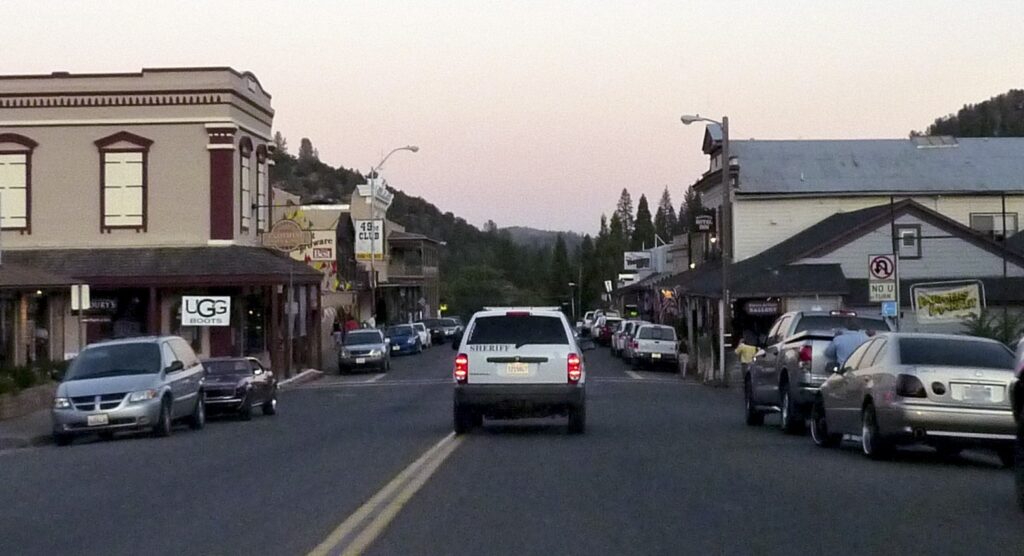
Water Desk Grantee Publication
This story was supported by the Water Desk’s grants program.
In the spring of 2013, Jocelyn Walters and her partners moved Nativearth, their small shoe business, into a warehouse in Mariposa Industrial Park that gave them more space to grow.
But there was one quirk of the new space she hadn’t foreseen.
The industrial park, which has only four businesses and isn’t connected to the town’s water system, gets its water from a well on her family’s property on the outskirts of Yosemite National Park. So Walters found herself helping run a water company from a shoe business.
Odd, tiny, rural water systems like this are a remnant of California’s past, but they face modern problems: The Mariposa Industrial Park Water Company has only one well — and it is highly contaminated with an industrial chemical known as PFOA (perfluorooctanoic acid).
As these ubiquitous, cancer-causing “forever chemicals” turn up in wells throughout the state, California’s small providers are struggling to replace their water or pay for treatment so they can comply with new state guidelines.
Small water districts “are not at all uncommon” in California, said Newsha Ajami, director of urban water policy at Stanford University’s Water in the West program.
Of the nearly 3,000 community drinking water systems in California, about 2,400 are considered small. About 1,500 of those have fewer than 100 connections each, and some are so small that they’re run by one person, Ajami said.
Small providers are more likely to violate health standards for drinking water, said Darrin Polhemus, deputy director of the State Water Resources Control Board’s Division of Drinking Water.
California’s small providers are struggling to replace water or pay for treatment so they can comply with new state guidelines.
About 90% of the approximately 300 California water systems that exceed standards for various contaminants serve fewer than 500 households or businesses, he said.
The contamination from “former chemicals” is not their fault — they often seep into groundwater from landfills, military bases and manufacturers – but these little water districts still must comply with state and federal health standards. Unlike private wells, which are almost entirely unregulated, any system that serves at least 25 people is regulated by the state water board.
“These very small systems often don’t have an office, the books are done on someone’s kitchen table,” Polhemus told the Public Policy Institute of California. “It’s almost impossible for most urban folks to conceive of what these systems face.”
Small water providers in rural counties don’t have enough customers to spread out the cost of installing expensive new treatment systems or repairing crumbling plumbing, said Ari Neumann, director of community and environmental services for the Rural Community Assistance Corporation.
One example is the Armona Community Service District in Kings County: It’s only about four square miles, has about 1,200 connections and serves 4,200 largely low-income residents. Customers pay about $30 a month for their water. Many nearby districts are even smaller, with fewer than 100 connections.
Jim Maciel, a board member of the Armona district, said state and federal regulations are often imposed without adequate funding for the communities most affected.
“These costs are really crippling disadvantaged communities,” Maciel said.
State funding sources are available to help small water systems meet drinking water standards. But Neumann said in some cases, the smallest systems aren’t eligible for state funding. For instance, non-municipal water companies, like the one in Mariposa, are technically run as businesses, so they cannot apply.
Macy Burnham, who owns Pine Grove Mobile Home Park in Crescent City, is struggling with how to pay for cleaning up perfluorinated chemicals.
The mobile home park, home to about 100 people, operates a single well. The well just barely exceeds the new state threshold — it’s at 11 parts per trillion of perfluorooctanoic acid (PFOA), which puts it one part per trillion over the guideline.
Burnham is considering installing a treatment system that would cost more than $100,000 to remove the PFOA. To afford it, he would likely have to refinance the mobile home park or raise rent, although he worries about the park’s low-income residents.
Another option, he said, is connecting to Crescent City’s municipal water system, but that also would be costly for residents. Burnham pays for testing, which he says amounts to $15,000 to $20,000 a year. Park residents use the water for free, but if they joined the city’s system, they would have to pay a monthly bill, he said.

At the Mariposa Industrial Park, every test of its only well has detected PFOA at levels far exceeding the state’s new 10 parts per trillion guideline, called a “response level.” The well’s average over the past four quarters of the year is 92.75 parts per trillion, more than nine times higher than that threshold, according to state water board data.
No one knows the source of the chemicals tainting the Mariposa well, although a county landfill is less than half a mile away. Perfluorinated chemicals, which were widely used throughout the United States for decades to produce Teflon, Scotchgard and other industrial products, often seep from landfills.
In most cases, the state water board advises systems to shut down or treat a well that exceeds guidelines for the chemicals, which have been linked to kidney cancer and other serious diseases.
But because it is the only well in the area, the Mariposa water can still be used, Thomas Archibald, president of the water system and owner of a business in the industrial park, wrote in a letter to users.
Tricia Wathen, a section chief for the state’s Division of Drinking Water, confirmed that the well is allowed to keep operating. The water is used only for sinks, toilets, irrigation and industrial processes because of its poor taste, odor and color, according to Wathen and Archibald. In addition to supplying the industrial park’s four businesses, the company sells the water to two propane companies and the county landfill.
But if state or federal standards, rather than the current, more flexible guidelines, are eventually imposed in California, this little water company would have to remove the chemicals or find another source of water. With only nine service connections and many miles between their well and any connection to Mariposa’s public system, that would be difficult and costly.
Archibald said he tries not to worry about the well. He said he can’t control new state standards any more than he can control if his well starts to dry up.
For now, tapping the well is a simple arrangement that has worked since the industrial park was founded in the 1980s.
Although it may seem strange that systems operate a single well, small water agencies are as old as California itself, said Adán Ortega, executive director of the California Association of Mutual Water Companies.
In the state’s early history, many farmers formed small cooperatives on their land to build basic water infrastructure for agriculture. Many towns eventually consolidated the systems into bigger municipal water systems. But in rural areas of the Central Valley, and in parts of Northern and Southern California and the Central Coast, many of these tiny systems remain.
While rights to surface water in California are extremely complicated, anyone who owned land could generally extract groundwater, Polhemus said. All you needed was a permit and you could drill a well.
In Mariposa, Walters said managing the water system’s finances from the family shoe business hasn’t been easy recently. At 88, she said she’s ready to hand the job over.
“I want to be totally retired,” she said.
This article was supported by a grant from The Water Desk, an independent journalism initiative based at the University of Colorado Boulder’s Center for Environmental Journalism.
In this series: California’s toxic legacy
Longform Story CSS Block


